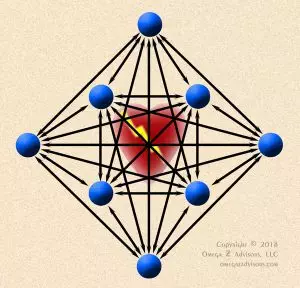Understanding Employee Engagement And Its Drivers
Employee engagement is in crisis. Gallup says no improvement has shown up in close to the twenty years it has tracked it. Why is that? Much has to do with understanding employee engagement and its drivers. The current thought lets us down.
Wrong Turns In Understanding Employee Engagement
For instance, a search on employee engagement gives words like commitment, involvement, connection, behavior and organization. These fail us. Ones that talk about enthusiasm get closer. The best ones though have two key words: passion or emotion and relationship.
Therefore, an engaged employee is one who is passionate about his relationship to the other employees in the company, their managers and the customers they all serve. Note. It’s people and relationships. Period.
Take organization. What is it really? It’s people. It’s relationships. “Organization” strips the human face of employee engagement. The word is old. It arose in the late 1800s when the industrial revolution came to dominate business. It was to describe systems and establishments, not people.
Now, take words like commitment, behavior and involvement. What drives those? It’s passion, emotion. Logic and reason don’t motivate. Emotions do. That’s why “e-motion” comes from two Latin words that mean “bring forth motion.”

Understanding employee engagement means understanding the roles emotions and relationships play and how to tap them.
Understanding Employee Engagement Means Understanding Emotions And Relationships
Simply, understanding employee engagement means understanding the roles emotions and relationships play and how to tap them. The two form the bedrock of employee engagement. Dig deeper into any definition of employee engagement. Emotions and relationships show up.
The other definitions are too shallow. They lead us astray. Their avoidance of emotions and relationships leads us to believe a process, a system, a comp plan, or a mission or values statement will solve it all. None of these work if relationships aren’t good.
Now, let’s be clear. Yes, emotions stir this passion for other employees and customers. Yet, passion shows itself differently in people. It does not always show up on the faces of some. It shows up as quiet, focused, relentless work too. Passion allows us to endure tough times and long hours.
Words Limit How To See The Problem
Thus, any employee engagement plan must begin by stirring passions and strengthening relationships. Then, it must leverage them for action.
Deep inside words like organization (company, firm, enterprise) are people and relationships. Deep inside words like commitment, connections and involvement are emotions and passions.
Employee engagement efforts have failed because today’s words pose the problem in a way that only has us scratching the surface. They don’t allow for going to the root.



Words of wisdom, Mike.
Our Dutch colleagues have been getting great results with their Employee Engagement Program for nearly 20 years – thanks to their approach, starting with mapping employee passion against management ambitions. I had the privilege of introducing the method in Vietnam and it worked brilliantly there too.
So there ARE better ways – and I’m sure you know lots of them!
Thank you, Marilyn, for the compliment. I would welcome seeing a link to their site or info. I’m sure you, personally, had a lot to do with that success in Vietnam. It’s good to hear from you. I trust you’ve been doing well? ~Mike
Indeed Mike there’s the eternal question of how much can be achieved by leading-edge methods and know-how, and how much depends on the presence of a skilled facilitator or coach. I’d love to think we could rely on the methods alone – it would make life so much easier!! – but there’s definitely a trade-off when it comes to getting results.
Yes, Marilyn, it would be. Life is not like that. The big problem I find is that people learn a process but not the principles behind it. So, when adaptation or adjustments are needed, the facilitator can’t. I draw the analogy to cooking. Just because you can follow a recipe doesn’t mean you’re a chef. There are principles to cooking behind those recipes that allow you to adjust with conditions and unforeseen events. This is especially true of credentialing programs. They’re more about learning processes, not principles.
This really resonates, Mike! We just concluded a ‘Learning for Sustainable Change workshop with several experienced facilitators among the participants, and their questions afterwards were about principles, and about personal development to strengthen coping capacity when things take an unexpected turn. https://legacy17.org/event/learning-for-sustainable-change/
I’m pleased you are seeing evidence of this, Marilyn. Teaching and training have become so formulaic that it’s more about processes and procedures than it is about principles. As you noticed, the mistake of this doesn’t show up until the process or procedure can’t cope with the unexpected.
Indeed, it’s been a consistent feature of our M&E since we started the Learning for Change workshops in 2009. We’ve had participants from over 40 countries, trained facilitators in Europe, Africa and Asia, and there’s a strong similarity: its the ‘people skills’ that count, that have the biggest contribution to make – in the workplace and elsewhere. In fact it’s the major rationale behind our new social enterprise.
I don’t know if I could recall it, Marilyn, but I read a study about two months ago. It was to find the best business skills to teach. It took place in the African frontier. They had three groups of rural Africans. The first group was the control. To the second they taught financial skills. To the third they taught social/people skills. The objective for all three were to start a small business (farming, production). While both groups did better than the control, the third group had the best results.
Not surprising but fascinating, Mike. If you CAN locate the study we’d love to see it.
Try this link, Marilyn. This is the article I read.
https://www.economist.com/news/business/21729454-among-small-business-owners-togo-least-psychology-beats-business-training-when-it-comes